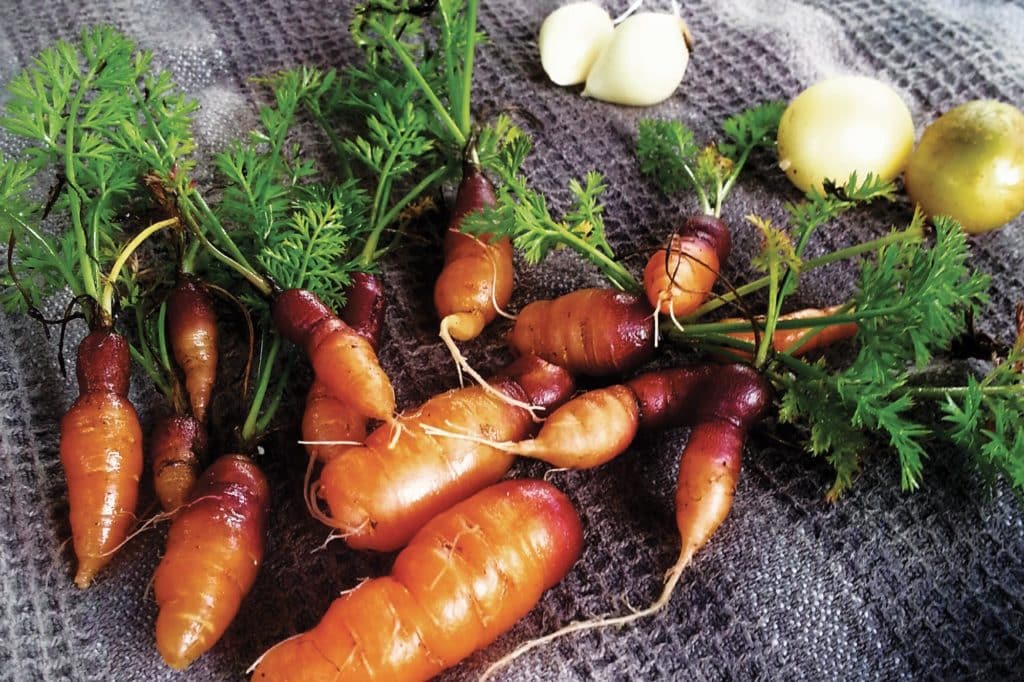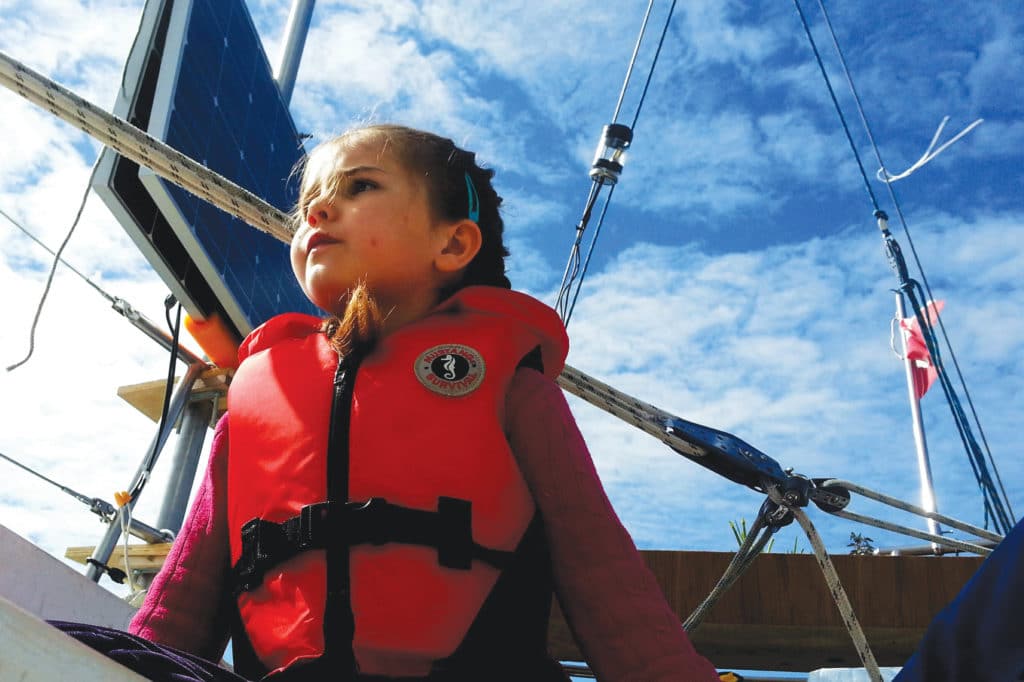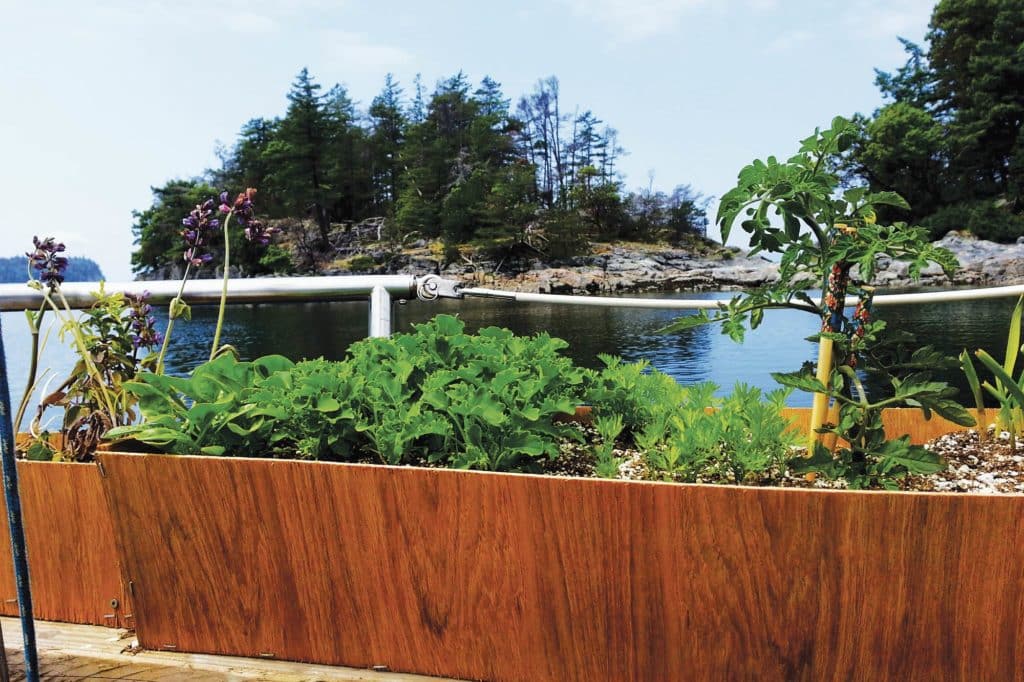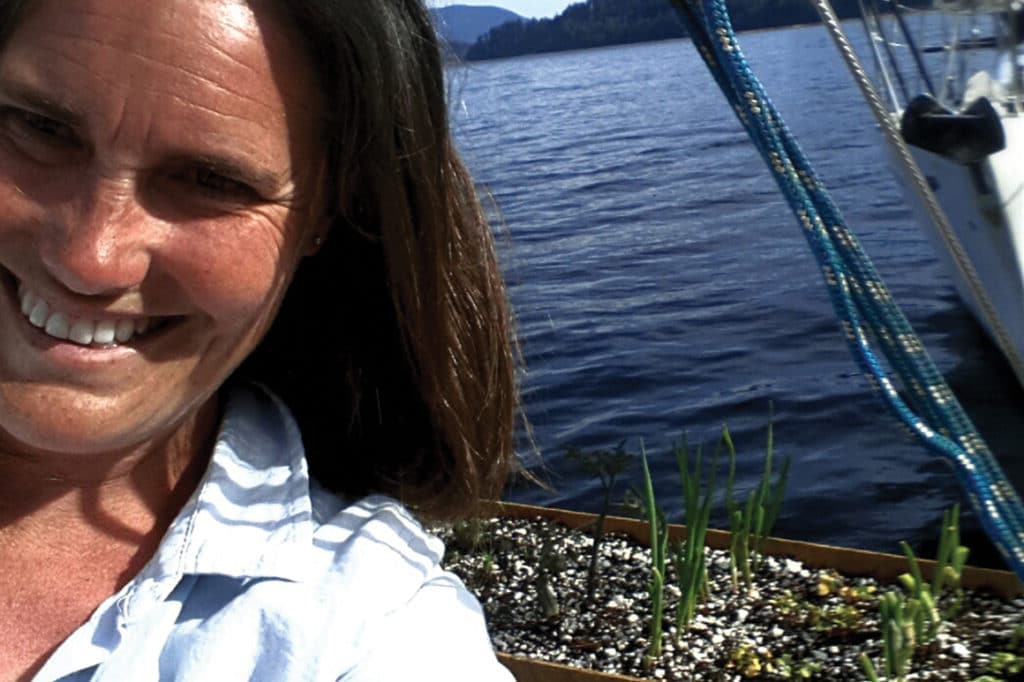
Mommy, is this spinach from our garden?” § “Absolutely,” I beamed as I set the dinette aboard our Catalina 30 with plates of fresh crab cakes atop a bed of tender spinach leaves, marking the first bit of bounty from my latest project—my taffrail-mounted garden.
Over the past eight years, my nomadic family has sailed and lived aboard three sailboats; enjoyed a rugged winter in a rustic northwest Canadian cabin; camped and cavorted alongside lakes and meadows in a motor home, and then in a “camperized” minivan; and spent three winters being rested and restored in the embrace of Bali, Indonesia. We even tried on normal life in a three-story walk-up apartment where we had three windows. And no backyard.
It was during our stay in the apartment—closed off from fresh air, gentle breezes and the feel of sunshine on my face—that I rediscovered gardening with a simple window garden grown from kitchen scraps. My window garden was small and didn’t produce much food, but it was the inspiration for my entry into gardening on the go.
Three years ago, we returned to life at sea. When springtime came around, trips ashore saw leaves unfurling and gardeners sharpening shears and digging out gardening gloves. The sight of jet-black potting soil in a planter box outside the supermarket taunted me with the promise of leafy green vegetables.
I was yearning to garden. My window-box garden had brought me such joy…but you can’t garden on a sailboat, right? Enter our family motto: “I know it can’t be done. But if it could, how would we do it?”

My boat garden began with a beach-salvaged wooden plank on the stern rail where I added daily to the mix of egg cartons and yogurt tubs to hold the cut ends of lettuce, green onions, garlic, a cherry tomato plant and a selection of fresh herbs.
Our first sail with the array of containers had me worried about the tiny green shoots. We were transiting from our home port of Vancouver, British Columbia, to Gabriola Island off the northern tip of Vancouver Island, set in the rugged cruising grounds of the West Coast Gulf Islands.
I secured the sturdier plants as best I could on the taffrail-mounted plank; the tender new seeds made the passage down below in the safety of the cabin. The wind forecast called for a steady sea breeze of 15 to 20 knots, promising to keep our boat moving at an unassuming yet surprisingly raucous 5 or 6 knots, saltwater spray threatening the tender plants with every wave crested, to say nothing of the jostling when tacking.
But we gardeners, well, we know the bold power of a tiny new plant—of a seedling so voracious to drink up sunlight and water and do that most natural thing: grow.
Having survived a southeaster in a journey across Georgia Strait and a nor’wester on the transit back, it was time to host the sea-trialed new plants in a permanent home of their own. At our next port of call in the inner recesses of Howe Sound, I set about building a taffrail garden box.
I’d read about the benefits of container gardening, but my limited space left much to be desired. With the rigging for the mainsheet and the boom hanging just forward of the stern-rail garden plank—and the access needed for the helmsman (which is usually me) to work the tiller underway, not to mention the added burden of additional windage created by having a structure of any size in that part of the vessel—I had a maddeningly tiny parcel of space within which to work.

Mother’s Day 2019 saw the completion of the family-built garden box, which consisted of three separate boxes, all secured to the original beach-salvaged plank on the stern rail awaiting soil.
Ah, yes. Soil. Where does one get potting mix while out at sea?
While tied to a dock in Port Mellon, British Columbia, I had a conversation with a fellow mariner. She was a mother of three whose resourcefulness in the constraints of life at sea would make even the hardiest of pioneer wives blush.
“Potting soil? I know where you can get some,” she exclaimed as we stood on the dock, surrounded by vast ocean and mountain wilderness. While onshore exploring with her own family, she had noticed a spot along a side road where some well-meaning local had dumped mound after mound of potting soil, along with the planters and pots they, for whatever reason, no longer wanted.
Armed with the X-marks-the-spot treasure map she drew me, I rowed ashore and soon found the great heaps of promised potting soil, rich with peat moss and peppered with vermiculite. A broad smile fixed to my face, I set about scooping the bounty into an old 12-liter rice sack I brought along for the job.
A half-dozen sailing excursions since that day, and I am confident in the garden—box and plants alike—on both port and starboard tacks. It’s still a startling sight to look aft and see my garden perched at a 45-degree angle to the horizon.
Adjusting to gardening at sea, I did some reading about pollination requirements for greenhouse plants and worried about the lack of natural pollinators out here. I kept a small paintbrush at the ready, borrowed from my children’s craft box, to sweep and transfer the delicate pollen from each flower to the next, but was thrilled to see nature’s little wonders—the humble bumblebee—darting to and fro among my three tiny yellow tomato-plant blossoms, even when anchored 300 feet from shore.

I have been conflicted between conserving precious stores of fresh water for the crew and sneaking just a little extra for watering my plants when we were nowhere near land. I’ve since taken to reusing my dishwater, cooled pasta water and any extra rainwater collected.
I’ve worried about staking my tomato plant when it grew beyond 6 inches. I initially embedded three chopsticks to form a stake, but it never grew much beyond another 6 inches higher. While my garden did grow, it firmly remained a microgarden. The kale and spinach produced tender, sweet leaves that served beautifully in a fresh green salad. The herbs grew to a somewhat stunted level, though reproduced enough to make our Sunday night dinners pop with flavor.
Every plant grew, but they were small, undersize, and tinier than land-based plants would be with the same amount of sunshine, soil, and summertime love. I’d been warned about this by other onboard gardeners.
And so, I need to learn. I love the curiosity and discovery of life lived at sea. I love the resourcefulness and ingenuity of sailors and our willingness to share and learn from one another. The secret to successful gardening at sea is out there—I just have to find it.
In the meantime, we are still able to partake of that most joyful part of gardening: the harvest. We’ve now enjoyed that brilliant splash of freshness that comes from tossing a handful of parsley into any dish, the bold crunch of green onions and chives added to dips and morning eggs, and the exquisite treat of dressing a plate with a brilliant, verdant bed of fresh, tender kale and spinach leaves.
As I stand in our cockpit, watering can in hand, tending to my plants each evening, I marvel at the splendors of this world. I can introduce my children to the gifts of sailing, travel, exploration, adventure and discovery, and feed them fresh ocean-grown kale at the same time.
Kate Gilgan is a writer, mother and hesitant adventurist. From a life at sea to a rustic wilderness cabin to life in Bali with their two youngest children, Kate and her husband, Michael, delight in family-style discovery and exploration.








